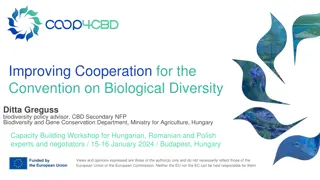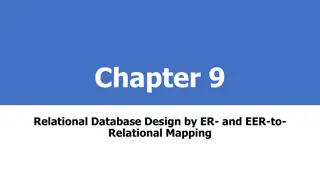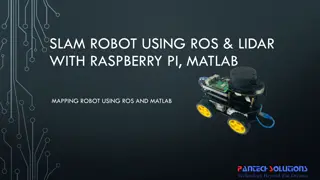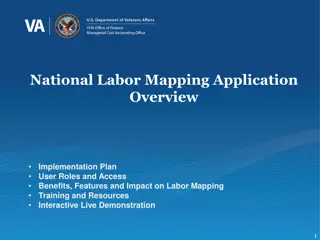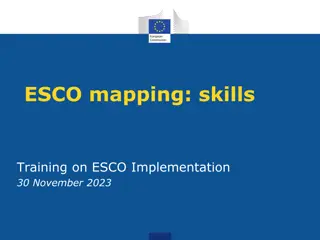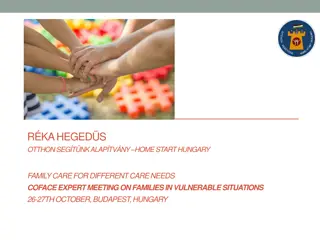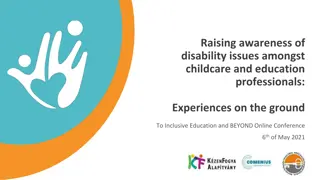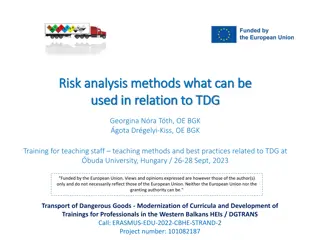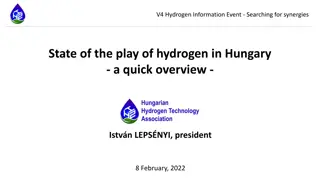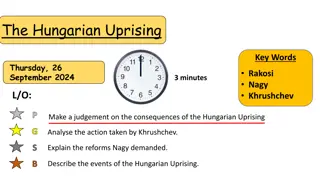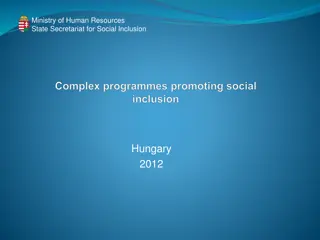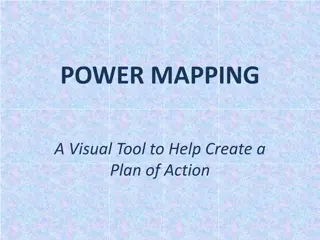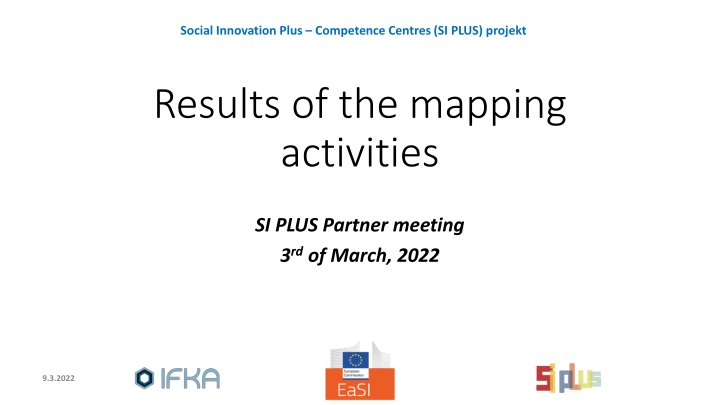
Social Innovation Plus Competence Centres Project Overview in Hungary
Explore the objectives, resources, and methodologies of the Social Innovation Plus Competence Centres (SI.PLUS) project in Hungary. Learn about mapping activities, stakeholder involvement, focus areas, policy instruments, and more to drive social innovation in the country.
Uploaded on | 0 Views
Download Presentation

Please find below an Image/Link to download the presentation.
The content on the website is provided AS IS for your information and personal use only. It may not be sold, licensed, or shared on other websites without obtaining consent from the author. If you encounter any issues during the download, it is possible that the publisher has removed the file from their server.
You are allowed to download the files provided on this website for personal or commercial use, subject to the condition that they are used lawfully. All files are the property of their respective owners.
The content on the website is provided AS IS for your information and personal use only. It may not be sold, licensed, or shared on other websites without obtaining consent from the author.
E N D
Presentation Transcript
Social Innovation Plus Competence Centres (SI PLUS) projekt Results of the mapping activities SI PLUS Partner meeting 3rd of March, 2022 9.3.2022
Social Innovation Plus Competence Centres (SI PLUS) project Overview Overview 1. Objectives, resources and methodology 2. Social innovation focus areas in Hungary 3. Policy instruments for social innovation in Hungary 4. Stakeholders of the social innovation ecosystem in Hungary 2025. 03. 20.
Social Innovation Plus Competence Centres (SI PLUS) project 1. Objectives, resources and methodology Objectives: 1. Defining the concept and focus areas of social innovation in Hungary 2. Mapping policy instruments to support social innovation in Hungary 3. Defining stakeholders of the social innovation ecosystem in Hungary Resources: 1. TinLab (Social Innovation Laboratory) baseline study 2. Own survey 3. Open databases of operative programs 2025. 03. 20.
Social Innovation Plus Competence Centres (SI PLUS) project 1. Objectives, resources and methodology Methodology TinLab (Social Innovation National Laboratory) baseline study Desk research analysis of the Baseline study 15 focus group interviews 66 participants 8 thematic clusters the social effects of digitization cultural innovation and the creative industries local developments, governance environmental social innovations, climate social welfare human systems (social and educational care system, health care) future of work, future economy social innovation management Survey quadruple helix stakeholders, 472 responses Cluster-specific problems & solutions (good practices) Cluster-specific needs and domestic resources Identification of potential partners / stakeholders extension of the stakeholder networks 2025. 03. 20.
Social Innovation Plus Competence Centres (SI PLUS) project 1. Objectives, resources and methodology Methodology Own survey Comparision of the TinLab szrvey and the SI PLUS survey Adjustment of the SI PLUS survey Exclusion of questions covered by the TinLab survey (not to overwhelm stakeholders) Keeping relevant questions not covered by the TINLab survey Integration of extra questions mapping additional relevant areas not covered by neither the TinLab, nor the SI PLUS survey Comparable results on SI PLUS partnership level Pilot questioning 37 responses Open databases of operative programs Desk research text and data analysis 2025. 03. 20.
Social Innovation Plus Competence Centres (SI PLUS) project 2. Main characteristics - TinLab Social innovation focus areas in Hungary Consensual characteristics Disputed characteristics Development Problem-solving Adaptability Response to social needs Targeted interventions Culture of cooperation and SI are strongly interlinked Novelty: Adaptation of good practice to a new field totally new solution Sustainability: the higher level of education and the higher status in the local society the respondent had, the higher importance is given to sustainability Origins: top-down and bottom-up approaches are considered equally successful solutions Importance/value of SI: biggest challenges of the Hungarian society are in the areas of education, health, the social welfare system, and employment policy - SI increases and improves the quality and efficiency of public services on these areas 2025. 03. 20.
Social Innovation Plus Competence Centres (SI PLUS) project 2. Main characteristics - IFKA Social innovation focus areas in Hungary Proportion of "Strongly agree" answers (%) Social Innovation characteristics Social innovation must contribute to the improved participation of those groups that are restricted in their scope of action (keyword: "empowerment") 100 Social innovation can also include projects/initiatives on a local level and does not necessarily have to claim to have a supra-regional impact. 88 Social innovation actions show the adaptivity of the society 88 Social innovation is a targeted intervention using new or novel solutions inspired by societal needs. 88 Social innovation should focus on the inevitably important changes of the society 82 Social innovation initiatives must identify and articulate societal problems and recommend solutions for policy makers. 76 Social innovation must be based on local needs 70 Social innovation must promote cooperation between civil society stakeholders and administrative authorities. 65 Social innovation actions must be implemented under local control 65 2025. 03. 20.
Social Innovation Plus Competence Centres (SI PLUS) project 2. Main characteristics - IFKA Social innovation focus areas in Hungary Importance of intervention fields for SI according to UN SDGs 90.00% Frequency of the intervention field 80.00% 70.00% 60.00% 50.00% 40.00% 30.00% 20.00% 10.00% 0.00% 2025. 03. 20.
Social Innovation Plus Competence Centres (SI PLUS) project 2. Main characteristics - IFKA Social innovation focus areas in Hungary Need for social innovation actions in Hungary according to social challenges 120% Frequency of stongly agree and agree answers (cumulated) (%) 100% 80% 60% 40% 20% 0% 2025. 03. 20.
Social Innovation Plus Competence Centres (SI PLUS) project 2. Stakeholders - TinLab Social innovation focus areas in Hungary Stakeholder groups Role in SI Educational and research institutions Most important actors State Financial support Local governments Support for self-organizing and civil initiatives Companies Strategic cooperations (mainly with municipalities and local administrations) (Role and responsibility in employment related SI is not recognized and acknowledged enough) Civil sector Encouraging self-organization NGOs Least potential actors (except the opinion of civil sector representatives) Media Providing communication platform for SI 2025. 03. 20.
Social Innovation Plus Competence Centres (SI PLUS) project 2. Stakeholders - IFKA Social innovation focus areas in Hungary Most important actors of SI in Hungary 90% Frequency of selection of stakeholders 80% 70% 60% 50% 40% 30% 20% 10% 0% 2025. 03. 20.
Social Innovation Plus Competence Centres (SI PLUS) project 2. Obstacles for SI Social innovation focus areas in Hungary Main obstacles Potential solutions Financial security for SI dedicated grants, guarantee programs, public and private funds for development, piloting and scaling SI Development of the legal, financial and regulatory environment Future-oriented and innovative municipal leadership Transparency; openness; knowledge sharing and working partnerships are needed Lack of financial resources Less innovative public administration culture Skilled workforce Involvement of volunteers and the training of innovators Expert support system Lack impact measurement and monitoring protocols and practices - very few (verified) good practices are available Targeted research, professionally sound collection and evaluation of good practices, disseminating good practices 2025. 03. 20.
Social Innovation Plus Competence Centres (SI PLUS) project 2. Need for support Social innovation focus areas in Hungary Need for support 120% Frequency of strongly agree and agree answers 100% 80% 60% (cumulated) (%) 40% 20% 0% 2025. 03. 20.
Social Innovation Plus Competence Centres (SI PLUS) project 3. Policy instruments for social innovation in Hungary Subject of analysis: Subject: EU financed operational programs extension of the scope is necessary Focus: role of social innovation in the development programs Examined periods: MFT (New Hungary Development Plan) + Sz chenyi 2020 (2007-2013; 2014-2020). 13 relevant programs identified (development of SI is an explicite goal) Social innovation as direct development goalof the programs EFOP (Human Resources Development OP) - 5.2.1.; 5.2.3.; 5.2.4; 5.2.5 (social services) Social innovation focus areas are represented among program goals: T MOP (Social Renewal OP) - 2.4.3-D & E (social cooperatives/employment) GINOP (Economic Development and Innovation OP) - 5.1.2-15; 5.1.3; 5.1.7 Innovative intervention areas (focus areas of SI) Analytical aspects: Implementation period Beneficiaries of subsidies Target groups of SI Budget/subsidy 2025. 03. 20.
Social Innovation Plus Competence Centres (SI PLUS) project 3. Policy instruments for social innovation in Hungary Database: Currently a total of 938 projects Key factors: Type of the program: funding, operational or subsidy program Name of applicant Name of project Country Municipality Total project budget Grant awarded (HUF) Fund structure (Sources/EU co-financing rate) Start of implementation End of implementation Profile / development area / innovation Category of intervention 2025. 03. 20.
Social Innovation Plus Competence Centres (SI PLUS) project 3. Policy instruments for social innovation in Hungary Overview - Human Resources Development Operational Program Number of beneficiaries Subsidy (Millon HUF) Subsidy (Millon EUR) Subsidy Programmes TESTING NEW METHODOLOGIES (PILOT) EFOP-5.2.1-17 8 2,056.8 5,6 A) NURSERY OPPORTUNITY SPOTS EFOP-5.2.3-17 expected: 20-33 n.a. n.a. SOCIAL INNOVATIONS SCALING OF ADAPTATIONS AND NEW METHODOLOGOES EFOP-5.2.4-17 8 2,344.1 6,3 ELABORATION OF NEW METHODOLOGIES EFOP-5.2.5-18 4 658.7 1,8 Main goals Activation of SI in the areas of family and youth services, health promotion, health services, lifelong learning, social care and services, child protection, child welfare, public education and social inclusion. Support for professional networking between nursery schools + human service providers + higher education institutions in less developed regions. Main impacts: Increase in the intensity and effectiveness of social cooperation 2025. 03. 20.
Social Innovation Plus Competence Centres (SI PLUS) project 3. Overview Social Renewal Operational Program Policy instruments for social innovation in Hungary Number of beneficiaries Subsidy (Millon HUF) Subsidy (Millon EUR) Subsidy Programmes T MOP-2.4.3-D-1-13/1; T MOP-2.4.3-D-1-13/2.; T MOP-2.4.3-D-2-13/1; T MOP-2.4.3-D-2-13/2 A. DEVELOPMENT OF SOCIAL ECONOMY SUBSIDY FOR SOCIAL COOPERATIVES FOR SELF-MAINTANENCE 359 10,575.0 28,6 B) PROFESSIONAL DEVELOPMENTS RELATED TO THE IMPLEMENTATION OF CAPACITY BUILDING PROGRAMS FOR SOCIAL ECONOMY AND CIVIL SOCIETY ORGANIZATIONS PROVIDING LABOUR MARKET SERVICES Main goals A) Supporting the emergence and spreading of new types of organisations (social cooperatives), which aim to ensure the livelihood and self-sustainability of marginalised members of society by reintegrating them into the world of work. Supporting the exit from public employment and the reintegration of those affected into the primary labour market. B) Providing professional assistance and reference services to the introduction of labour market service standards to the very broad target group of labour market service providing NGOs (beneficiaries of the T MOP 2.6.2) Providing professional support and networking services to new social cooperatives established and developed as a result of the T MOP-2.4.3 subsidy programmes KoopeR ci + 2.4.3. E-13/1 (Priority project) T MOP- 1 (OFA) 796.8 2,2 Main impacts: The effectiveness of adapting to economic and labor market changes has increased 2025. 03. 20.
Social Innovation Plus Competence Centres (SI PLUS) project 3. Overview Economic Development and Innovation Operational Program Policy instruments for social innovation in Hungary Number of beneficiaries Subsidy (Millon HUF) Subsidy (Millon EUR) Subsidy Programmes GINOP-5.1.2-15 priority project GINOP-5.1.3-16 GINOP-5.1.7-17 MArketMate 3 (OFA +IFKA+PM) 2,800.0 7,6 A) INCENTIVISING SOCIAL ENTERPRISES 166 355 6,858.9 17,304.2 18,5 46,8 Main goals Dynamisation and stabilization of already operating civic and non-profit organizations and already operating social enterprises - by promoting the sustainable business model-based production, marketing and market access of marketable products and services - in order to create long lasting and sustainable employment opportunities. Prepare social enterprises to be able to operate independently from state aid, basing their sustainability on market revenues.. Supporting the creation of new social enterprises on the basis of existing civil and non-profit business organisations; strengthening and stabilizing already operating social enterprises by providing them non-financial services in various areas: Business plan pre-evaluation Business model development, Product development and marketing, Social impact measurement Consulting Main impacts: The local bussiness development programs and the new initiatives for employment hev been boosted with positve impact on the local communities 2025. 03. 20.
Social Innovation Plus Competence Centres (SI PLUS) project 4. Stakeholders of the social innovation ecosystem in Hungary Composition of data collecting: Name (Private persons or organizations) Basic data of the organization Level of SI PLUS Collaboration Field of Operation Project and other SI development experience Connected best practices Networks, networking 2025. 03. 20.
Social Innovation Plus Competence Centres (SI PLUS) project 4. Results Improvements in the subject area can be analysed at program or project level,provides a great basis for planning; evaluation, proposals, etc.; Networking (information and professional networks) can be initiated database (continuously growing); Existing good practices , can be identified and analysed as a starting point for further development IFKA has thus also laid the foundations for the establishment of the Centre of Excellence: 1. MAs can be assisted in the design and implementation of support programmes to boost SI 2. Domestic social innovators and ecosystem actors will be supported to implement future programs 3. The process of networking and knowledge transfer can be initiated, as well as complex capacity and competence development in the field. 2025. 03. 20.

